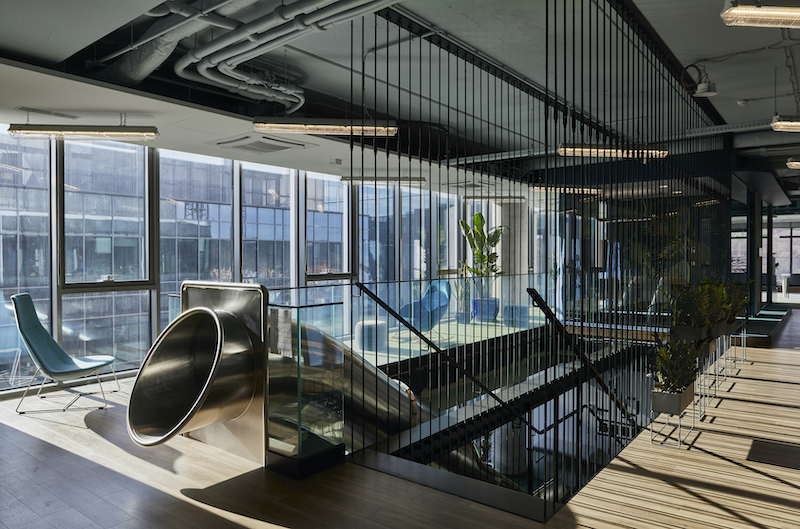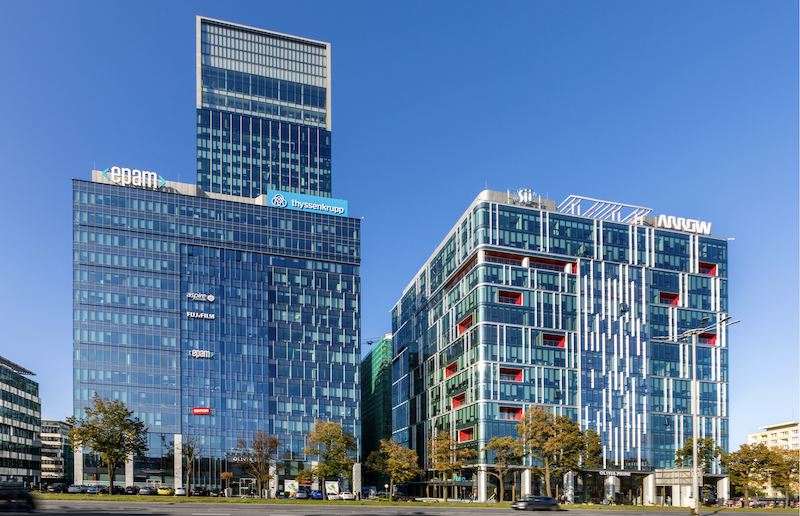The largest office complex in northern Poland is the first building to receive the highest WELL Health Safety Rating, as audited by the International WELL Building Institute (IWBI).
The Olivia Business Center, located in Gdansk, is the complex, with 230,000 sm (2.48 million sf) of office space within eight completed buildings. Olivia Building Center has been expanding since 2010. More than 8,500 people work at Olivia, whose tenants include Amazon, Bayer, PwC, and ThyssenKrupp.
The contractor for the construction of each building has been Pekabex, a leading precast concrete manufacturer. Konior and Partners developed the complex’s architectural concept, which has been continued by Gdynia-based BJK Architekci Studio. The complex’s primary investor is Maciej Grabski, cofounder of Wirtualna Polski (Virtual Poland), one of the country’s big media companies.
A LOCAL DOCTOR HELPS DEVISE SAFETY PROTOCOLS
A spokesperson for Olivia Business Center tells BD+C that the decision to make the buildings healthier stemmed from discussions, in February 2020, with Professor Krzysztof Korzeniewski, MD, Ph.D, the director of the Department of Epidemiology at a regional hospital. Korzeniewski assisted in developing procedures and planning to protect the buildings’ occupants from COVID-19.
The Olivia Business Center is one of the first complexes in the world to install ion air purification technology in its buildings. The devices saturate all internal areas with ventilated air that contains ions capable of destroying viruses, bacteria and other pathogens. The filters in the air handling units were raised to F7 from G4, and sensors for pollution and particulate matter were installed. The intensity of the air exchange in the buildings is controlled based on real-time CO2 measurements.
To maximize tenant safety, key-card sterilizers were installed, and elevator settings changed so that lift cabins stay open while in stay-by mode.
Elevators were among the common areas (including lobbies and access paths to parking lots) to which an active titanium coating was applied to ensure surfaces that are touched often are free from pathogenic organisms. The coating—developed by Lumichem and scientists at Jagiellonian University—eliminates bacteria, fungi, and viruses that come into contact with surfaces, and breaks down their residues into carbon dioxide and water.

Ventilation upgrades were among the improvements made to Olivia Business Center.
A PERFECT SCORE
To achieve its score of 25 out of 25 from IWBI (which launched its rating system last January), Olivia Business Center also made some structural changes to windows and façade in all of the buildings. Inside, occupants are directed by signage to walk in one direction to comply with social distancing guidelines. The frequency of the buildings’ cleaning regimen was increased. Cigarette sales are banned. And the building’s owner organizes free and open-to-everyone healthy activities for occupants, which include Nordic walking, cycling, or yachting excursions on the Baltic Sea.
“The safety and quality of life of our tenants are an absolute priority for us, which is why we were happy to undergo such a thorough and extensive certification process that prioritizes the comfort and well-being of our tenants,” said Konrad Danecki, head of Olivia Business Center’s utilities department, in a prepared statement.
The Center did not disclose the cost of these changes.
Related Stories
Design Innovation Report | Apr 19, 2023
Reinforced concrete walls and fins stiffen and shade the National Bank of Kuwait skyscraper
When the National Bank of Kuwait first conceived its new headquarters more than a decade ago, it wanted to make a statement about passive design with a soaring tower that could withstand the extreme heat of Kuwait City, the country’s desert capital.
Design Innovation Report | Apr 19, 2023
Meet The Hithe: A demountable building for transient startups
The Hithe, near London, is designed to be demountable and reusable. The 2,153-sf building provides 12 units of business incubator workspace for startups.
Green | Apr 18, 2023
USGBC and IWBI unveil streamlined certification pathway for LEED and WELL green building programs
The U.S. Green Building Council, Green Business Certification Inc., and the International WELL Building Institute released a streamlined process for projects pursuing certifications for the LEED green building rating system and the WELL Building Standard. The new protocol simplifies documentation for projects that are pursuing both certifications at the same time or that have already earned one certification and are looking to add the other.
Office Buildings | Apr 13, 2023
L.A. headquarters for startup Califia Farms incorporates post-pandemic hybrid workplace design concepts
The new Los Angeles headquarters for fast-growing Califia Farms, a brand of dairy alternative products, was designed by SLAM with the post-Covid hybrid work environment in mind. Located in Maxwell Coffee House, a historic production facility built in 1924 that has become a vibrant mixed-use complex, the office features a café bordered by generous meeting rooms.
Market Data | Apr 11, 2023
Construction crane count reaches all-time high in Q1 2023
Toronto, Seattle, Los Angeles, and Denver top the list of U.S/Canadian cities with the greatest number of fixed cranes on construction sites, according to Rider Levett Bucknall's RLB Crane Index for North America for Q1 2023.
Contractors | Apr 10, 2023
What makes prefabrication work? Factors every construction project should consider
There are many factors requiring careful consideration when determining whether a project is a good fit for prefabrication. JE Dunn’s Brian Burkett breaks down the most important considerations.
Mixed-Use | Apr 7, 2023
New Nashville mixed-use high-rise features curved, stepped massing and wellness focus
Construction recently started on 5 City Blvd, a new 15-story office and mixed-use building in Nashville, Tenn. Located on a uniquely shaped site, the 730,000-sf structure features curved, stepped massing and amenities with a focus on wellness.
Architects | Apr 6, 2023
New tool from Perkins&Will will make public health data more accessible to designers and architects
Called PRECEDE, the dashboard is an open-source tool developed by Perkins&Will that draws on federal data to identify and assess community health priorities within the U.S. by location. The firm was recently awarded a $30,000 ASID Foundation Grant to enhance the tool.
Architects | Apr 6, 2023
Design for belonging: An introduction to inclusive design
The foundation of modern, formalized inclusive design can be traced back to the Americans with Disabilities Act (ADA) in 1990. The movement has developed beyond the simple rules outlined by ADA regulations resulting in features like mothers’ rooms, prayer rooms, and inclusive restrooms.
Sustainability | Apr 4, 2023
NIBS report: Decarbonizing the U.S. building sector will require massive, coordinated effort
Decarbonizing the building sector will require a massive, strategic, and coordinated effort by the public and private sectors, according to a report by the National Institute of Building Sciences (NIBS).
















